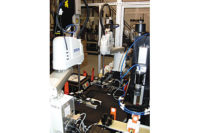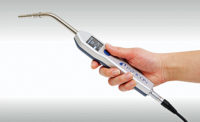The Deere & Co. assembly plant in Augusta, GA, uses automated guided vehicles (AGVs) to build the company's Series 5000 tractor. In an integrated and networked process that takes less than 4 hours, each AGV transits a 1,452-foot assembly line along which approximately 3,500 tasks are performed as each tractor passes through 106 workstations.
One of the critical steps in the tractor assembly process is leak testing of the air conditioning system. A single leak the size of a bacteria cell can cause the loss of 1 gram of refrigerant per year, potentially rendering an air conditioning system inoperable in a few years.
"Our customers depend on the reliability of our air conditioning systems," says Bill Tasch, assembly engineer at the Augusta plant. "They sit in the tractor's glass cab for hours at a time, and it would not be easy to haul a tractor to a shop for repairs if the AC system had a slow leak. To maintain high customer satisfaction, we make sure we have a tight AC system before we charge it with refrigerant, and before it leaves the factory."
Because of the complexity of its operations, Deere needed a leak-detection tool that could be integrated into the automated assembly process. This meant reliably and consistently performing within the cycle time allowed at each workstation along the AGVs' path.
Traditional wet methods of air conditioner leak testing-submersion and soap-bubble testing-were not viable options because they could not be easily automated. These methods are also prone to operator error and incapable of detecting leaks as small as those of concern to Deere engineers.
The company evaluated a leak testing method using helium as a tracer gas, but this method proved to be too expensive due to the price of the helium gas and the cost of the sophisticated helium mass spectrometry equipment. There were also concerns about the difficulty of maintaining the testing apparatus.
Ultimately, the company installed the Sensistor ISH2000 hydrogen leak detector from Inficon.
"The instrument fits perfectly into our new automated assembly process with its mistake-proofing system," says Tasch. "The test procedure is straightforward, and the operator is guided through each step."
After the cab is installed on a tractor chassis, the AGV brings the tractor to the leak testing station. Once it is there, the air conditioning system is automatically evacuated of air and filled to the correct pressure with a gas mixture containing 5 percent hydrogen and 95 percent nitrogen, using a TGC 28 tracer gas controller, also from Inficon.
The operator searches for leaks by positioning the hydrogen probe at seven joints. A programmable logic controller (PLC) with a touch screen interface displays graphical images of each test location. Auditory signals lead an operator sequentially through a 10-second test of each joint.
In the event there is a leak, the probe sounds an alarm, after which the operator is usually able to repair the problem by tightening a connection or replacing a seal. Retests can be performed immediately, because the hydrogen tracer gas dissipates readily. One of the advantages of using hydrogen is that it does not cling to surfaces like other tracer gasses and refrigerants, therefore eliminating false rejections on retests.
Once the air conditioning system has been shown to be leakproof, the AGV moves the tractor to the next station, where the air conditioning system is charged with refrigerant.
"We test with hydrogen trace gas prior to filling the system with refrigerant, because it would be environmentally irresponsible to inject refrigerant into an untested system," explains Tasch. "It is also easier to perform repairs on systems that do not contain refrigerant. We simply perform the repair, and then retest and send the tractor on its way to the next workstation."
For more on leak testing, call Inficon at 315-434-1100 or visit www.inficon.com.


